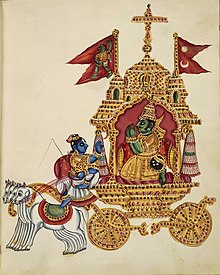The Bhagavad Gita
| Bhagavad Gita | |
|---|---|

Krishna and Arjuna at Kurukshetra, c. 1830 painting
|
|
| Information | |
| Religion | Hinduism |
| Language | Sanskrit |
| Verses | 701 |
The Bhagavad Gita (Sanskrit: भगवद्गीता, bhagavad-gītā in IAST, Sanskrit pronunciation: [ˈbʱaɡəʋəd̪ ɡiːˈt̪aː]; lit. "Song of the Lord"), often referred to as simply the Gita, is a 700-verse Hindu scripture in Sanskrit that is part of the Hindu epic Mahabharata (chapters 23–40 of the 6th book of Mahabharata).
The Gita is set in a narrative framework of a dialogue between Pandava prince Arjuna and his guide and charioteer Lord Krishna. Facing the duty as a warrior to fight the Dharma Yudhha or righteous war between Pandavas and Kauravas, Arjuna is counselled by Lord Krishna to "fulfill his Kshatriya (warrior) duty as a warrior and establish Dharma." Inserted in this appeal to kshatriya dharma (chivalry) is "a dialogue ... between diverging attitudes concerning methods toward the attainment of liberation (moksha)". The Bhagavad Gita was exposed to the world through Sanjaya, who senses and cognises all the events of the battlefield. Sanjaya is Dhritarashtra's advisor and also his charioteer.
The Bhagavad Gita presents a synthesis of the concept of Dharma, theistic bhakti, the yogic ideals of moksha through jnana, bhakti, karma, and Raja Yoga (spoken of in the 6th chapter) and Samkhya philosophy.
...
Wikipedia
